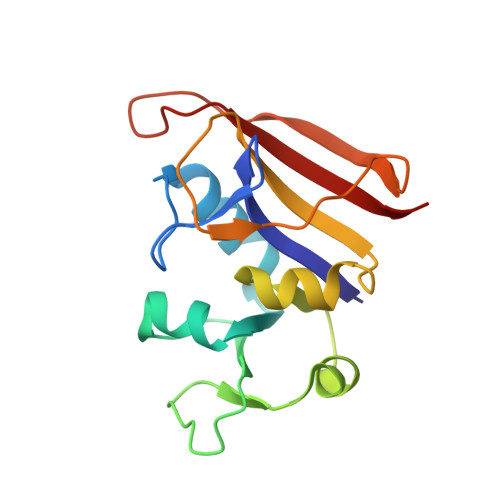Crystal structures of wild-type and mutant methicillin-resistant Staphylococcus aureus dihydrofolate reductase reveal an alternate conformation of NADPH that may be linked to trimethoprim resistance.
Frey, K.M., Liu, J., Lombardo, M.N., Bolstad, D.B., Wright, D.L., Anderson, A.C.(2009) J Mol Biology 387: 1298-1308
- PubMed: 19249312
- DOI: https://doi.org/10.1016/j.jmb.2009.02.045
- Primary Citation of Related Structures:
3F0B, 3F0U, 3FQ0, 3FQC, 3FQF, 3FQO, 3FQV, 3FQZ - PubMed Abstract:
Both hospital- and community-acquired Staphylococcus aureus infections have become major health concerns in terms of morbidity, suffering and cost. Trimethoprim-sulfamethoxazole (TMP-SMZ) is an alternative treatment for methicillin-resistant S. aureus (MRSA) infections. However, TMP-resistant strains have arisen with point mutations in dihydrofolate reductase (DHFR), the target for TMP. A single point mutation, F98Y, has been shown biochemically to confer the majority of this resistance to TMP. Using a structure-based approach, we have designed a series of novel propargyl-linked DHFR inhibitors that are active against several trimethoprim-resistant enzymes. We screened this series against wild-type and mutant (F98Y) S. aureus DHFR and found that several are active against both enzymes and specifically that the meta-biphenyl class of these inhibitors is the most potent. In order to understand the structural basis of this potency, we determined eight high-resolution crystal structures: four each of the wild-type and mutant DHFR enzymes bound to various propargyl-linked DHFR inhibitors. In addition to explaining the structure-activity relationships, several of the structures reveal a novel conformation for the cofactor, NADPH. In this new conformation that is predominantly associated with the mutant enzyme, the nicotinamide ring is displaced from its conserved location and three water molecules complete a network of hydrogen bonds between the nicotinamide ring and the protein. In this new position, NADPH has reduced interactions with the inhibitor. An equilibrium between the two conformations of NADPH, implied by their occupancies in the eight crystal structures, is influenced both by the ligand and the F98Y mutation. The mutation induced equilibrium between two NADPH-binding conformations may contribute to decrease TMP binding and thus may be responsible for TMP resistance.
- Department of Pharmaceutical Sciences, University of Connecticut, 69 N. Eagleville Rd., Storrs, CT 06269, USA.
Organizational Affiliation:


















